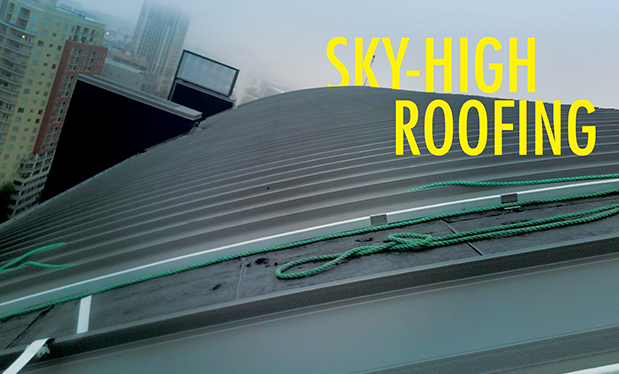During November 2015, NRCA staff embarked on another international training event—this time a 10-day journey in Mumbai, India, to deliver a roofing industry train-the-trainer program. The training program was commissioned by the Dr. Fixit Institute of Structural Protection and Rehabilitation (DFI-SPR), Mumbai, the waterproofing brand of Pidilite Industries Ltd., Mumbai, one of India's largest adhesive manufacturers.
During my trip, I saw firsthand how India currently is experiencing dynamic growth in construction and achieving success through its vision for achieving excellence in roof system application skills, increasing productivity and improving worker safety.
t A brief history
Many studies, such as those conducted by the Department of Agriculture's Economic Research Service, have documented the trend in the U.S. through the latter half of the 20th century of its population migrating from rural agricultural communities to larger metropolitan cities in search of employment opportunities (see the figure). This trend increased demand for residential and commercial buildings and infrastructures, which, in turn, drove a need to improve how buildings are built by developing codes and standards, conducting research to develop better-performing building materials and modernizing construction methods while increasing the safety and productivity of the construction workforce.
Similar to what the U.S. experienced during the latter 20th century, many countries, including India, are experiencing population growth, shifting demographics and migrations from rural agricultural societies to urban environments.
To gain insight into the rapid growth of India's construction market, consider the following.
India's current population is 1.25 billion, similar to the size of China's population (1.36 billion) but nearly four times the size of the U.S. population of 322 million. India's citizens live in a land area (1.14 million square miles) that only is 32 percent the size of the U.S. (3.53 million square miles) and 31 percent the size of China (3.69 million square miles).
During 2013, India's gross domestic product (GDP), representing the monetary value of all goods and services produced within a nation's geographic borders during a specified time period, was $2.07 trillion, or 11.9 percent of the U.S.' GDP of $17.4 trillion and 20 percent of China's GDP of $10.4 trillion the same year. India's and China's unemployment rates during 2013 were nearly half the U.S. unemployment rate—3.6 percent in India; 4.6 percent in China; and 7.4 percent in the U.S.
And finally, the construction sector contributes 8.1 percent to India's total GDP compared with China's 7 percent and only 2 percent in the U.S., according to findthedata.com. Other published reports on www.makeinindia.com state migration from rural to urban areas increased urban populations 32 percent during the early 2000s and is projected to increase another 56.5 percent by 2030. This migration already is straining India's city infrastructure and housing capacities well beyond their limits.
Urban populations in India are increasing to densities that currently exceed its construction industry's ability to build. The need to quickly ramp up construction of residential and commercial buildings and corresponding infrastructure in India's cities in the immediate future is apparent. In response to these needs, India's roofing and waterproofing industry is taking steps to organize its growth and development. Lacking its own organized industry trade association, roofing materials manufacturers from India are turning to NRCA for help.
First steps
During the early 2000s, a delegation of Indian roofing and waterproofing manufacturers began attending NRCA's annual convention and trade show. In 2004, NRCA leadership attended its first organized roofing industry trade show in Chennai, India. Delegations from NRCA and India manufacturers continue to attend each other's conferences and exhibitions to share current industry statuses and discuss mutually beneficial collaboration.
In January 2006, NRCA staff provided two three-day training programs in India—one in Delhi and another in Mumbai—to introduce Indian manufacturers to various types of U.S. roof systems and coverings. The training event also was sponsored by Pidilite Industries, which opened the training to numerous design professionals and installers throughout India.
Since the initial training event in 2006, new single-ply and self-adhering low-slope membrane roof systems began to enter India's roofing market, some imported and some manufactured in new production facilities in India. Indian manufacturers soon realized their workforce needed training to properly install these relatively new systems, and discussions about more advanced training began between NRCA and DFI-SPR during the ensuing years. At the 2015 International Roofing Expo® (IRE), NRCA and DFI-SPR reached an agreement to provide technical and application training addressing U.S. low-slope roof systems.
According to Tirtha P. Banerjee, head of training for DFI-SPR, the training's purpose is to provide workers with updated skills.
"The reason [for the training] is to make sure our applicators know the right way to apply these [new] systems," he says. "The foremen and supervisors need to upgrade their knowledge and skills about these systems, and when they do so, they are reaching for new career goals and improving their careers."
A train-the-trainer program strategy was mutually agreed upon, and the topics included basics of low-slope roof system design; polymer-modified bitumen systems; single-ply thermoset and thermoplastic systems; self-adhering membrane systems; liquid-applied systems; below-grade waterproofing systems; flashing system design for each system type; and basics of adult education and training facilitation skills.
The five-day training curriculum consisted of 25 percent classroom theory; 10 percent instructor demonstrations; and 65 percent hands-on application practice using custom-designed mockups. Formal tea breaks, an Indian custom, also were scheduled twice per day.
Banerjee says the students most enjoyed learning the details.
"What they liked most about the training was how to detail the applications [flashing details] and the high degree of interaction between them and the instructors," he says. "They really engaged in the practical parts of the training, and the instructors answered all their questions well. Our goals for this training were accomplished, and [the students] already have trained more than 200 workers in the field."
Thirty-seven students completed the five-day program.
What's next?
Banerjee also recognizes a need for additional training throughout India.
"Our Dr. Fixit Institute vision is for the India industry to have a greater understanding of roof system technologies and application," he says. "To do this, our consultants and architects also need a deeper understanding of waterproofing and roofing technologies. We are doing a lot more to establish standards and codes, but we still need to do a lot of work."
He adds: "We have the Bureau of Indian Standards, but we still have a lot of older practices, and these different construction techniques reference different codes and standards. We have few standards, such as ASTM International."
When asked about worker safety, Banerjee says there also is room for improvement.
"Every construction site has a safety department," he says. "But the applicators don't follow [the safety standards] because they are not enforced. This needs to be improved."
In early December 2015, soon after the training in India was completed, and quite serendipitously, another major roofing and waterproofing manufacturer from India traveled to the U.S. to meet with NRCA staff and discuss the topic of worker safety. (Because of his close and direct relationships with the Labour Bureau Government of India and other government officials, he wishes to remain anonymous at this time.) During the meeting, he shared general statistics about India's construction industry, stating: "In India, there are approximately 35 million construction workers with about eight deaths for every 1,000 workers." This reflects agreement with Banerjee's comments about worker safety in India.
Subsequently, discussions about a worker safety program already have begun between stakeholders. At press time, some Indian government officials stated their desire to attend the 2016 IRE in Orlando, Fla., to meet with NRCA staff and discuss possible next steps for India's workforce development.
A worthwhile initiative
Construction provides much-needed work opportunities for some of the poorest and most marginalized members of India's society. The training and education needs for all areas of India's roofing and waterproofing industry are extensive, and NRCA is proud to be a part of these initiatives. Doing so helps export our industry's best practices, advances adoption of international codes and standards, broadens the market opportunities for U.S. manufacturers, contractors and other roofing professionals, and it helps elevate the roofing industry worldwide.
John Schehl, CAE, RRC, is executive director of Roof Integrated Solar Energy.™
For an article related to this topic, see "An international affair," February 2015 issue, page 46



